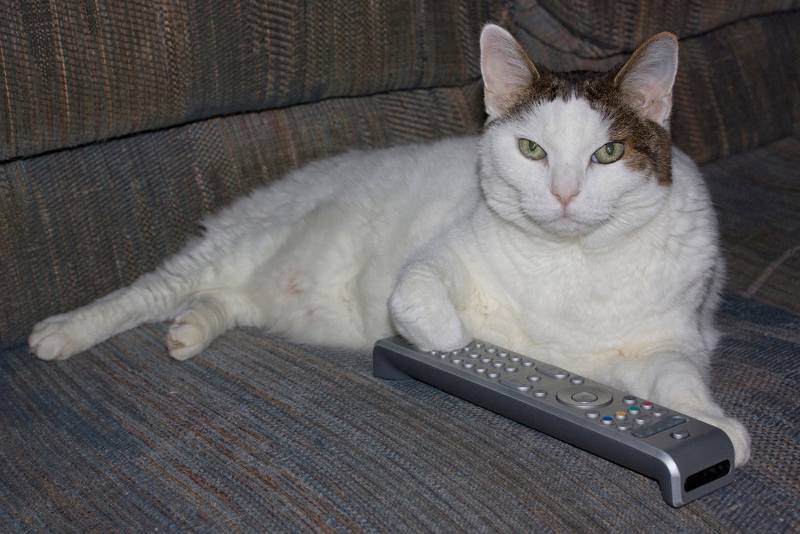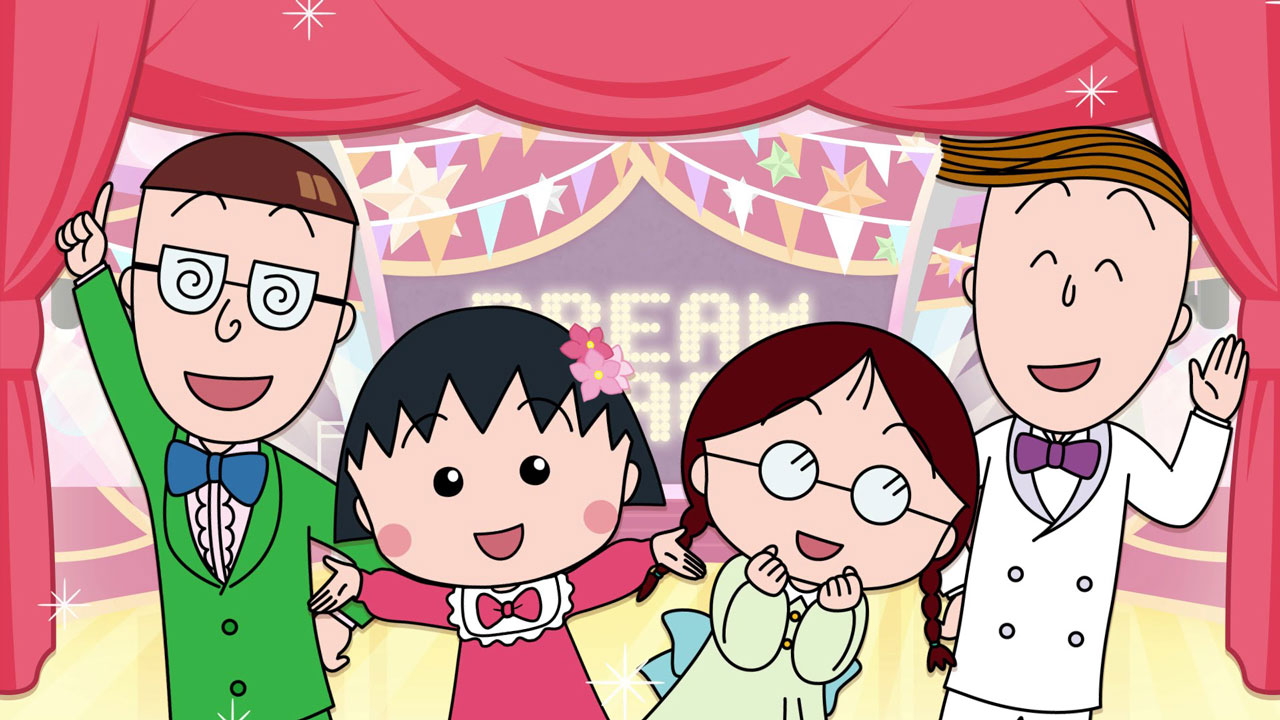When I started learning Japanese, the inability to pick up on words in anime, movies and music frustrated me. Aside from "Okā-san!", "Otō-san!" and "Kusou!", I had trouble catching words and phrases and my listening skills developed at a slow rate. I used to sit back and wonder, "Will I ever be able to understand what they're saying!?"
A trip to the video rental shop answered my question. Instead of the anime, drama or comedy sections, I scoped out family and children's DVDs. Among them I discovered Chibi Maruko-chan, Oden-kun, and other shows that served as more suitable learning material for a beginner. Although not easy, these programs featured language closer to my level, particularly when compared to the complicated plots of the anime and movies I had been watching.
At last I could improve my listening skills while being entertained! Some of these cartoons, like Anpanman, are made for toddlers and feature simple stories, simple Japanese and clear pronunciation. Others, like Nintama Rantarou, take aim at older children and feature a slight level-up in Japanese and plot. But all of the following shows can be used as study materials. But don't take my word for it – give them a try!
Strategizin'

When using anime as a learning tool, kicking back with a bag of popcorn won't lead to major gains (although chewing gum might help.) It's best to formulate a concrete plan of attack. Koichi offers tips, tricks and strategies on the subject in his excellent article How to Learn Japanese from Anime, and here are some techniques I find useful.
Watch an episode multiple times to challenge your ear. During the first viewing, turn the subtitles off and try to pick out single words or listen for understanding. You can repeat the process as many times as you want and even take some notes. On the final viewing, turn on the subtitles to see how successful you were.
When watching Japanese cartoons, shows or movies, decide whether to listen for overall understanding or for single words or phrases. When I first started learning Japanese I focused on listening for words and phrases I had studied. As my Japanese improved I focused on trying to understand the overall content of statements and conversations and ignored focusing on single words.
A more painstaking method involves listening to the dialogue and trying to write out the Japanese. This method works best when the anime features Japanese subtitles to compare your work with afterwards. You can also use this method with Japanese music and then check the lyrics online. This technique's advantage lies in its focus on raw Japanese. Since you don't need to understand what you write, you can invest total focus on listening. Although time consuming, this study method's big yields means it's worth investing time in.
As with any studying strategy, it's best to try a variety of approaches to find what works best for you. But even when you do, changing things up keeps studying fresh and revives motivation.
Get to the List Already!

This list features cartoons with varying degrees of Japanese. True beginners (one year of study or less) may not be able to use cartoons for a study tool with great results. But thanks to their simple plots and clear Japanese, the series in this list offer a great starting point for listening improvement.
Anpanman (アンパンマン)
One of Japan's most popular childrens' characters is based on a familiar snack food. Welcome to the world of Anpanman, an anpan (bread filled with anko, or sweet red bean paste) headed hero. Sure his weakness is water, but when dampness strikes, the kind old baker Uncle Jam saves the day with a fresh head of bread.
What started as a series of picture books by Takashi Yanase in 1973 grew into an industry spawning clothing, toys, video games, snacks and a hit cartoon. Making its debut in 1988, the cartoon continues today with over one thousand episodes and annual movies and tv specials.
Anpanman reigns supreme among children ages 0 to 4, so the dialogue and stories stay simple. Beginners looking to get their feet wet in Japanese should find Anpanman their best bet. And as a bonus you learn about the Japanese diet: from melonpan to currypan, the delicious cast of characters features foods common to bakeries and supermarkets across Japan.
- Pros: Aimed at young children. Anpanman features simple stories and simple dialogue perfect for Japanese language beginners of any age. Learn about Japan's unique takes on bread.
- Cons: Almost too cute and maybe too childish. Also, Anpanman's characters might make you hunger for foods unavailable outside of Japan.
Chirubii (チルビー)
Make it past Chirubii's cute, dancing rabbit opening and you're in for a treat. The series features (slightly) animated versions of popular Japanese picture books with enthusiastic narration and colorful background music. Chirubii aims at children without becoming too infantile. By featuring books from various authors, this cartoon's visual style varies from episode to episode and the stories never get stale. Watch Chirubii and experience some of Japan's best picture books while leveling up your listening skills!
- Pros: Chirubii offers Japanese aimed at the youngest native Japanese learners, so it makes for great listening practice! The variety of stories and art keeps Chirubii fresh and interesting.
- Cons: The minimalist animation may turn off some viewers.
Nihon Mukashibanashi (Nihon Mukashibanashi 日本昔話)
If children's books and anthropomorphic bread don't interest you, you might enjoy some good old fashioned folktales. Nihon Mukashibanashi offers up classic stories brought to life by various artists in various animation styles. Like the two series mentioned above, Nihon Mukashibanashi's Japanese stays simple, although some of rural and old folks' Japanese might be difficult to pick up on. Overall Nihon Mukashibanashi offers deep cultural roots with a relaxing vibe.
- Pros: Like Chirubii, Nihon Mukashibanashi's assorted art styles keep the visuals interesting. The traditional source material offers a distinct Japanese flavor.
- Cons: Like most fables and fairy tales, the stories get repetitive. How is it that so many old men saved magical sea-life?
Ganbare! Oden-kun (がんばれ!おでんくん)
Welcome to coolsville. Unlike the childish Anpanman and Chirubii and old-fashioned Nihon Mukashi-banashi, Oden-kun offers up a hip, groovy and occasionally psychedelic flavor. Created by actor (All Around Us), writer (Tokyo Tower: Mom and Me, and Sometimes Dad) and all-around talent Lily Frank, Oden-kun reflects its author's unique personality and art style.
The story stars Oden-kun, a small kinchaku or mochi-filled bag of tofu who lives in a big pot of oden (a Japanese stew of sorts). His friends include egg-headed girls, a wise old slice of daikon radish and even a sausage-headed alpha-male. Oden-kun uses the mochi in his head to get him, his friends and his customers out of hairy situations. But don't worry, after being pulled from the pot and eaten, Oden-kun and his pals eventually reappear for new adventures.
- Pros: With slow and clear pronunciation, Oden-kun's Japanese is easy to pick up on. Unique plots and characters make Oden-kun one of the most fun children's cartoons to watch.
- Cons: Some viewers might find the show's depictions of god (dude chilling on a cloud with a beard and bishop hat) offensive. Another one that might give you cravings for Japanese dishes that you can't get at home.
Nintama Rantarou (Nintama Rantarou 忍たま 乱太郎)
If ninjas are more your style, give Nintama Rantarou a try! The show focuses on the titular hero Rantarou and his friends Shinbei and Kirimaru as they train to be ninjas at Ninja Gakuen. Childish jokes (some involving poop) give you the chance to learn childish Japanese words (like poop) and make this show a fun watch.
- Pros: Did I mention ninjas! And a great sense of humor.
- Cons: Fast talking makes this one more difficult than the previous series on the list.
Sazae-san (サザエさん)

A long-running classic, Machiko Hasegawa's Sazae-san depicts the everyday trials and tribulations faced by a Japanese housewife and her family. Although often compared to Chic Young's Blondie character of the comic-strip of the same name, Patrick Drazen compares Sazae-san to Peanuts' Charlie Brown, as a "wishy-washy" character engaged in the balancing act of everyday life (Anime Explosion 143). Watch Sazae-san to tune up your Japanese skills while reflecting on a low-key idealization of family life in Japan.
- Pros: The long running classic is grounded in reality. Suited for all audiences.
- Cons: Born from the post-war 1940's, perhaps Sazae-san's world is overly romanticized.
Chibi Maruko-chan (ちびまる子ちゃん)

My favorite family show, ,the long running Chibi Maruko-chan has made the jump from analog to HD. While Sazae-san focuses on a Japanese housewife, Chibi Maruko-chan follows elementary school student Sakura-chan and her experiences at school, at home and around her neighborhood. Another show based in reality, Sakura's reactions and thought-process reflect an authentic innocence that make the series both touching and humorous. There are plenty of dubiously legal subs on YouTube.
- Pros: A funny, realistic portrayal of a Japanese child's world.
- Cons: The narrator's sense of humor, which often flatly states the obvious, may get lost in translation.
Crayon Shin-chan (クレヨンしんちゃん)
If a cheeky (in more ways than one) version of Japanese family life is what you're looking for, give Crayon Shin-chan a look. Shin-chan and his eccentric family put humanity's imperfect, but realistic shortcomings on display. Shin-chan is best compared to Bart Simpson of the early 1990s, a young troublemaker with his own colloquialisms. But like the later Simpsons episodes, Shin-chan's universe is not constrained to reality. Crayon Shin-chan offers a crude but "real" representation of Japanese family life with language to match. As such, it's one of the more difficult series on the list.
- Pros: Learn Japanese as cheeky little kids speak it.
- Cons: One of the most difficult to understand on the list, thanks to Shin-chan's voice and pronunciation.
Dragon Ball (ドラゴンボール)
No introduction necessary, but here goes: The world-famous series that grew into the definitive shonen action-battle series started off as an action-comedy. Before Dragon Ball Z popularized fights spanning hundreds of episodes (at least that's how they felt) and extended episode recaps, Dragon Ball kept things relatively simple and humor-based. Fans of the series know what to listen for and some of the characters' slow, clear pronunciation make Dragon Ball an apt Japanese learning tool. And given its world-wide popularity, Dragon Ball should be the most accessible series on the list.
- Pros: As a popular series abroad, it's easy to obtain. Those who have already watched it in English know the plots and therefore what kind of words to listen for. For example, in the clip above Roshi (the old man) is trying to get Lunch (the girl) into the bathroom to peep on her. Since I know his intent, I know to listen for words like bathroom and bathtub.
- Cons: When the action gets heavy, useful vocabulary dwindles. Goku's (the main character) voice can be the most difficult to listen to.
Doraemon (ドラえもん)
The big, blue robot cat from the future debuted on the printed page as a manga in 1969 and on television in 1973. Doraemon has been a mainstay of Japanese television and movie theaters ever since. Sent from the future to help his inventor's great great grandfather Nobita, Doraemon can pull all sorts of crazy inventions from the "magic pocket" on his tummy (think Felix The Cat's magic bag of tricks).
Doraemon revolves around Nobita's school and home life, though it occasionally crosses into the fantasy realm. Thanks to its sense of humor and innocent fun, Doraemon remains a favorite among all ages and you'd be hard-pressed to find a more recognized and beloved character in Japan.
- Pros: Witness the closest thing Japan has to Mickey Mouse (aside from Kitty-chan?), in a long running, influential cultural mainstay. Even after hundreds of episodes, Doraemon's unique and silly inventions will keep you guessing.
- Cons: Although the inventions are interesting, the series' plots get repetitive. Nobita's bungling helplessness gets old.
Jarinko Chie (じゃりン子チエ)
Experience family life – Osaka style. Jarinko Chie deals with the eccentricities of Kansai life, the seedier, more in-your-face side of Japan. Experience Chie's hard-knock life, complete with yakuza encounters and badass cats. Chie offers a refreshing change from the other child characters on this list as she faces the challenges of a broken home head-on and proves more responsible than many of the adults that surround her. But beware, taking on Jarinko Chie means taking on Kansai-ben (Osaka's local dialect). Jarinko Chie is like a gritty, more capable Chibi Maruko-chan.
- Pros: Experience Kansai-ben!
- Cons: Experience Kansai-ben…
SpongeBob Squarepants (スポンジョボブ)
The popular American cartoon series has also seen success in Japan. SpongeBob and his friends speak with loud, clear pronunciation. While stories get crazy, the simple jokes and visuals make the dialogue easy to understand. Since the series is originally in English, it's easy to find a source to compare the Japanese to. But since the series is originally in English, getting your hands on Japanese episodes might require buying the Japanese DVDs.
- Pros: American humor (for Americans). Voice actors speak very clearly.
- Cons: Some jokes don't translate accurately, so the Japanese dialogue may differ from the English equivalent. Japanese episodes are hard to come by.
Access

Access to these shows would have been nearly impossible just a decade ago. But thanks to the internet, most are easily accessible. Video sites like Youtube offer episodes that can be viewed for free. There's even an official Doraemon channel you can subscribe to. Can't find the series by searching in English? Try searching in Japanese. If Youtube doesn't give you what you want, try different video hosting sites (like Dailymotion).
Online marketplaces like Amazon.jp, Rakuten, Yesasia, Play-asia, and CDJapan offer many of these series on DVD or Bluray. Both shops have made international ordering easy by offering English versions of their stores and accepting foreign credit cards. Some series can be found at Amazon.com. I found Oden-kun, Chibi Maruko-chan, Anpanman, and even Jarinko Chie there.
But beware of region restrictions that prevent imported disks from playing on domestic DVD players. Luckily region-free DVD players that can play DVDs from any country are inexpensive. Amazon sells units at under $40.
Although I don't have a region free DVD player, I set my computer's DVD drive to region 2 so I can play Japanese DVDs. I also play them on my Japanese Playstation 3. Although playing import DVDs can be problematic, there are many easy solutions.
If you want English subtitles, things get a bit trickier. Most Japanese DVDs do not feature English subs. Japanese SpongeBob DVDs feature both Japanese and English options. And most Western-released Dragon Ball DVDs feature both languages. So those are you're best bets. Funimation's Western release of Crayon Shin-chan, however, does not feature Japanese language options. So if you buy Crayon Shin-chan DVDs for study purposes, make sure to get the Japanese release.
Doin' Time

As Koichi explains, learning Japanese from anime takes work. Passively watching while reading English subtitles results in few gains if any. But by buckling down and deciding on a specific strategy we can dramatically level up our listening levels.
When it comes to listening skills, we all develop at different speeds, but putting in the time and effort can help push things along. But finding the right study material helps. And since many Japanese children's shows feature simple stories and simple Japanese, they make a great starting point. Most of the series mentioned above feature 15 minute shorts, a length perfect for repeated, focused viewings.
And don't forget to go back later to check your progress. I love revisiting a series from years ago. Nothing has been more satisfying than cultivating what feels like a sixth sense and understanding dialogue that was once just a bunch of indecipherable sounds.
